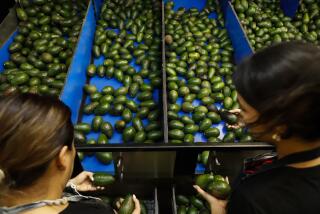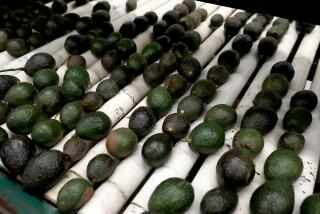Market Watch: How to buy avocados at their best
Choosing the right avocado for the season can be surprisingly tricky, even or especially at farmers markets. Good choices are available all year, but a knowledgeable buyer needs to juggle four factors: variety, season, growing area and fruit size. Every month or two the scenario changes, requiring buyers to stay nimble.
Avocados are valued chiefly for their oil content, which gives them their buttery texture and flavor. The trees bloom in the spring and the earliest varieties start to bear in late autumn. At the beginning of the season, oil levels in most varieties are low; these increase as the months go by, but this change is not very evident from the fruit’s outward appearance.
In fact, to keep growers from prematurely harvesting fruit that will disappoint buyers with its low oil content, the California Avocado Commission publishes a schedule of maturity release dates, organized by variety and fruit size. This calendar, which changes somewhat each year depending on the maturity of the crop, applies to all growers, at farmers markets as well as commercial shippers.
Each variety matures at a different time: The largest fruits of Bacon reached legal status on Oct. 21 this year; Fuerte on Oct. 27; Zutano on Nov. 16; and Hass on Nov. 28. But these are minimum requirements, and the fruit of any individual variety does not become optimally rich and buttery until weeks or months after its official release.
In addition, larger fruit mature more rapidly than smaller fruit, because the flowers that produced them bloomed earlier in the season, giving the fruit more time to accumulate oil. For example, the largest Hass reached maturity on Nov. 28, but the smallest fruit won’t be released until Jan. 16. So at this time of year, when much of the fruit of standard varieties like Hass and Fuerte is marginal in oil content, it’s definitely worth looking for the largest specimens.
This is counterintuitive for many savvy produce buyers, who may suspect that huge fruits have been bred and manipulated for size at the expense of flavor. Indeed, commercial growers and retail chains often like larger produce because it is less expensive to harvest and handle, per pound, and usually fetches higher prices. But early-season avocados represent an exception: everything else being equal, there is a direct correspondence between size and quality.
The varieties themselves differ considerably in maturity and intrinsic qualities. Hass, which dominates commercial production, is an excellent variety later in the season, in late winter and spring, but is not the best choice right now, when even the largest fruits are still rather bland. It’s better to select one of the other major varieties that start maturing at this time, such as Bacon, Fuerte and Zutano.
These varieties, with their thin, green skins that readily show bruises, have been virtually abandoned by commercial avocado marketers, who find it more profitable during the fall and early winter to sell Hass imported from Chile and Mexico instead of less durable domestic varieties. But the more tender varieties, at their best now, are still readily available at farmers markets in Southern California.
Zutano is early and relatively cold-hardy compared with other avocados, but even at full maturity has relatively bland, watery flesh. Some people like that; in Florida all the avocados have lower oil content than Hass, but growers make the best of it by advertising them as “diet avocados.” Even for those who prefer Hass, a lighter taste is a nice chance of pace once in a while.
Fuerte, the former mainstay of California’s avocado industry, at its best is arguably the finest of all commercially grown varieties, with an intense, nutty flavor. The larger sizes are getting pretty good right now, but will be richer in a month; the smaller sizes won’t be at their best until February.
Bacon, which originated in Buena Park in 1928, is one of the best choices in December and early January. It’s got a nice, sweet, nutty flavor, with adequate oil, although it will never be as rich as Hass and Fuerte at their peaks.
This advice about timing applies specifically to the main avocado production zone in north San Diego County, from Fallbrook, Escondido, Valley Center and adjacent areas like Temecula, or other warm districts like Riverside and Redlands. Fruit from northern and coastal districts in Ventura, Santa Barbara and San Luis Obispo counties mature a month or two later. Larger fruit from earlier varieties can still be good now from these areas, but in general their time to shine is later.
A very few growers from these northern areas still have old-crop Hass, which is recognizable by its generally darker, matte appearance; new-crop Hass is green and glossy. Old-crop fruit is risky for customers, because it can be overmature and rapidly go rancid, and for growers, who can be mistakenly cited by agricultural inspectors for selling immature new-crop fruit. At its best, however, from the very coolest growing areas like Morro Bay, old-crop Hass can be delightfully, preternaturally rich in oil, almost like avocado cheese.
As Seinfeld famously remarked, “fruit is a gamble.” But especially when it comes to farmers market avocados, it definitely helps to know what you’re buying.
More to Read
Eat your way across L.A.
Get our weekly Tasting Notes newsletter for reviews, news and more.
You may occasionally receive promotional content from the Los Angeles Times.









